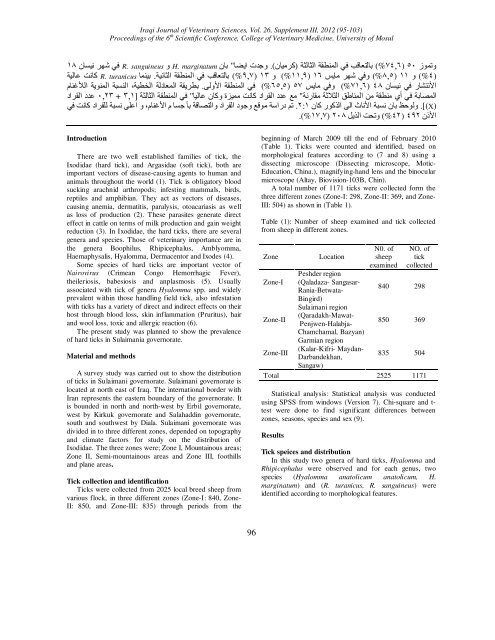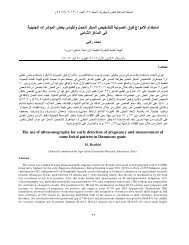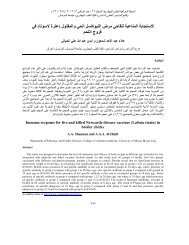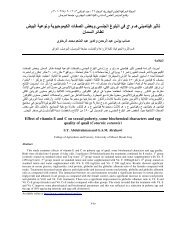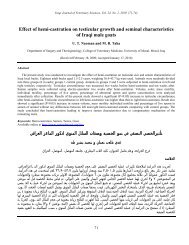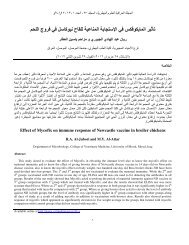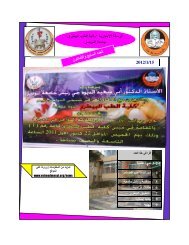fulltext (pdf) - College of Veterinary Medicine, University of Mosul, Iraq
fulltext (pdf) - College of Veterinary Medicine, University of Mosul, Iraq
fulltext (pdf) - College of Veterinary Medicine, University of Mosul, Iraq
Create successful ePaper yourself
Turn your PDF publications into a flip-book with our unique Google optimized e-Paper software.
<strong>Iraq</strong>i Journal <strong>of</strong> <strong>Veterinary</strong> Sciences, Vol. 26, Supplement III, 2012 (95-103)<br />
Proceedings <strong>of</strong> the 6 th Scientific Conference, <strong>College</strong> <strong>of</strong> <strong>Veterinary</strong> <strong>Medicine</strong>, <strong>University</strong> <strong>of</strong> <strong>Mosul</strong><br />
في شھر نيسان<br />
و<br />
بالتعاقب في المنطقة الثالثة (كرميان). وجدت ايضا"<br />
وتموز<br />
كانت عالية<br />
و بالتعاقب في المنطقة الثانية.<br />
و وفي شھر مايس<br />
في المنطقة األولى. بطريقة المعادلة الخطية، النسبة المئوية الألغنام<br />
وفي مايس<br />
األنتشار في نيسان<br />
عدد القراد<br />
المصابة في أي منطقة من المناطق الثالثة مقارنة" مع عدد القراد كانت مميزة وكان عاليا" في المنطقة الثالثة<br />
ولوحظ بان نسبة األناث الى الذكور كان ٢:١. تم دراسة موقع وجود القراد والتصاقة بأ جسا م األغنام، و اعلى نسبة للقراد كانت في<br />
وتحت الذيل ٢٠٨<br />
١٨<br />
R. sanguineus<br />
بينما R. turanicus<br />
٠,٢٣ + ٣,١]<br />
بان H. marginatum<br />
(%٩,٧) ١٣ (%١١,٩) ١٦<br />
(%٦٥,٥) ٥٧<br />
.(%١٧,٧)<br />
(%٧٤,٦) ٥٠<br />
(%٨,٥) ١١ (%٤)<br />
(%٧١,٦) ٤٨<br />
.[(X)<br />
األذن (%٤٢) ٤٩٢<br />
Introduction<br />
There are two well established families <strong>of</strong> tick, the<br />
Ixodidae (hard tick), and Argasidae (s<strong>of</strong>t tick), both are<br />
important vectors <strong>of</strong> disease-causing agents to human and<br />
animals throughout the world (1). Tick is obligatory blood<br />
sucking arachnid arthropods; infesting mammals, birds,<br />
reptiles and amphibian. They act as vectors <strong>of</strong> diseases,<br />
causing anemia, dermatitis, paralysis, otoacariasis as well<br />
as loss <strong>of</strong> production (2). These parasites generate direct<br />
effect in cattle on terms <strong>of</strong> milk production and gain weight<br />
reduction (3). In Ixodidae, the hard ticks, there are several<br />
genera and species. Those <strong>of</strong> veterinary importance are in<br />
the genera Boophilus, Rhipicephalus, Amblyomma,<br />
Haemaphysalis, Hyalomma, Dermacentor and Ixodes (4).<br />
Some species <strong>of</strong> hard ticks are important vector <strong>of</strong><br />
Nairovirus (Crimean Congo Hemorrhagic Fever),<br />
theileriosis, babesiosis and anplasmosis (5). Usually<br />
associated with tick <strong>of</strong> genera Hyalomma spp. and widely<br />
prevalent within those handling field tick, also infestation<br />
with ticks has a variety <strong>of</strong> direct and indirect effects on their<br />
host through blood loss, skin inflammation (Pruritus), hair<br />
and wool loss, toxic and allergic reaction (6).<br />
The present study was planned to show the prevalence<br />
<strong>of</strong> hard ticks in Sulaimania governorate.<br />
Material and methods<br />
A survey study was carried out to show the distribution<br />
<strong>of</strong> ticks in Sulaimani governorate. Sulaimani governorate is<br />
located at north east <strong>of</strong> <strong>Iraq</strong>. The international border with<br />
Iran represents the eastern boundary <strong>of</strong> the governorate. It<br />
is bounded in north and north-west by Erbil governorate,<br />
west by Kirkuk governorate and Salahaddin governorate,<br />
south and southwest by Diala. Sulaimani governorate was<br />
divided in to three different zones, depended on topography<br />
and climate factors for study on the distribution <strong>of</strong><br />
Ixodidae. The three zones were; Zone I, Mountainous areas;<br />
Zone II, Semi-mountainous areas and Zone III, foothills<br />
and plane areas.<br />
Tick collection and identification<br />
Ticks were collected from 2025 local breed sheep from<br />
various flock, in three different zones (Zone-I: 840, Zone-<br />
II: 850, and Zone-III: 835) through periods from the<br />
beginning <strong>of</strong> March 2009 till the end <strong>of</strong> February 2010<br />
(Table 1). Ticks were counted and identified, based on<br />
morphological features according to (7 and 8) using a<br />
dissecting microscope (Dissecting microscope, Motic-<br />
Education, China.), magnifying-hand lens and the binocular<br />
microscope (Altay, Biovision-103B, Chin).<br />
A total number <strong>of</strong> 1171 ticks were collected form the<br />
three different zones (Zone-I: 298, Zone-II: 369, and Zone-<br />
III: 504) as shown in (Table 1).<br />
Table (1): Number <strong>of</strong> sheep examined and tick collected<br />
from sheep in different zones.<br />
Zone<br />
Zone-I<br />
Zone-II<br />
Zone-III<br />
Total<br />
Location<br />
Peshder region<br />
(Qaladaza- Sangasar-<br />
Rania-Betwata-<br />
Bingird)<br />
Sulaimani region<br />
(Qaradakh-Mawat-<br />
Penjwen-Halabja-<br />
Chamchamal, Bazyan)<br />
Garmian region<br />
(Kalar-Kifri- Maydan-<br />
Darbandekhan,<br />
Sangaw)<br />
N0. <strong>of</strong><br />
sheep<br />
examined<br />
840<br />
850<br />
835<br />
2525<br />
NO. <strong>of</strong><br />
tick<br />
collected<br />
298<br />
369<br />
504<br />
1171<br />
Statistical analysis: Statistical analysis was conducted<br />
using SPSS from windows (Version 7). Chi-square and t-<br />
test were done to find significant differences between<br />
zones, seasons, species and sex (9).<br />
Results<br />
Tick speices and distribution<br />
In this study two genera <strong>of</strong> hard ticks, Hyalomma and<br />
Rhipicephalus were observed and for each genus, two<br />
species (Hyalomma anatolicum anatolicum, H.<br />
marginatum) and (R. turanicus, R. sanguineus) were<br />
identified according to morphological features.<br />
96


